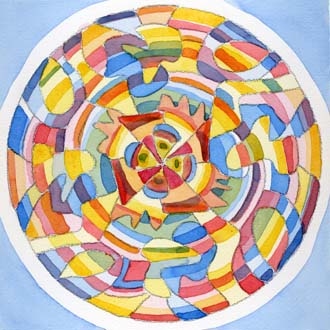May 22, 2008

Each of these mandalas pictures the universal in a singular expression, and thus mirrors our own individual window on eternity. For seven years, between November 13, 2004 and November 13, 2011, I offered daily my individual perspective on this Great Mystery. You may download from these archives and use the mandalas, provided this blog's URL is credited. To purchase a CD copy of the collection, hi-res prints, license information, see henryreed.com
2 Comments:
THE COSMIC DANCE
Hamlet’s Mill
http://www.craigr.com/books/hamlets.htm
The ancients viewed the earth as not just the sphere on which we live, but as the space-time in which we live. The "space" was viewed as extending to the "four corners of the earth." These corners are the points in the sky with respect to which the sun rises on the winter and summer solstice and the spring and fall equinoxes. In many cultures the path to the afterlife was said to be via a gateway in the constellation in which the sun rose at the time of the spring equinox.
As you might be aware, the earth's axis is tilted with respect to the plane in which it orbits. While the tilt is constant, the planet is said to "wobble" on that axis, resulting in the north pole pointing somewhere other than Polaris over a long period of time (over 26,000 years for one complete "wobble"). As the axis wobbles, the constellations at the four corners rotate. (The Fifth Dimension taught us all about this in the famous song "Age of Aquarius" from the 70's musical Hair. We are currently in the age of Pisces (the fish), meaning that the sun rises in the sign of Pisces on the morning of the spring equinox. The coming age will be Aquarius.) This wobbling is called "precession" and the period of time during which the sun rises in the same astrological sign on the spring equinox is the "time" of the current space-time in which we're said to live.
The ancients described precession in stories describing the complete destruction of the heavens and earth. It makes sense… over a period of time the four corners are unhinged and a "new earth" with new corners is established.
"Hamlet's Mill" is one of the common themes running through the world's mythology: that of a mill which turns on a spindle representing the Earth turning under the heavens (or more precisely: the heavens turning over the earth; or more precisely still, the heavens turning over the "four-cornered earth"). Some major event occurs and the mill is destroyed. In the process, a great ruler/king/god is overturned and a new ruler/king/god comes into power. This is not just an adventure story but rather is a scientific explanation of precession. The ruler/king/god associated with the old astrological sign is overthrown by the new one.
I've done a less-than-satisfying job of explaining all this. It's quite fascinating but you need to read it to get the whole story. One of the conclusions is that our cultural arrogance (derived from our belief in evolution) has kept us from admitting that the ancients had this knowledge, and its kept us from understanding our own history.
"Mistaking cultural history for a process of gradual evolution, we have deprived ourselves of every reasonable insight into the nature of culture. It goes without saying that the still more modern habit of replacing "culture" by "society" has blocked the last narrow path to understanding history. Our ignorance not only remained vast, but became pretentious as well."
(page 71)
Copyright 1996-1999 © by Craig Rairdin. All Rights Reserved.
Post a Comment
<< Home